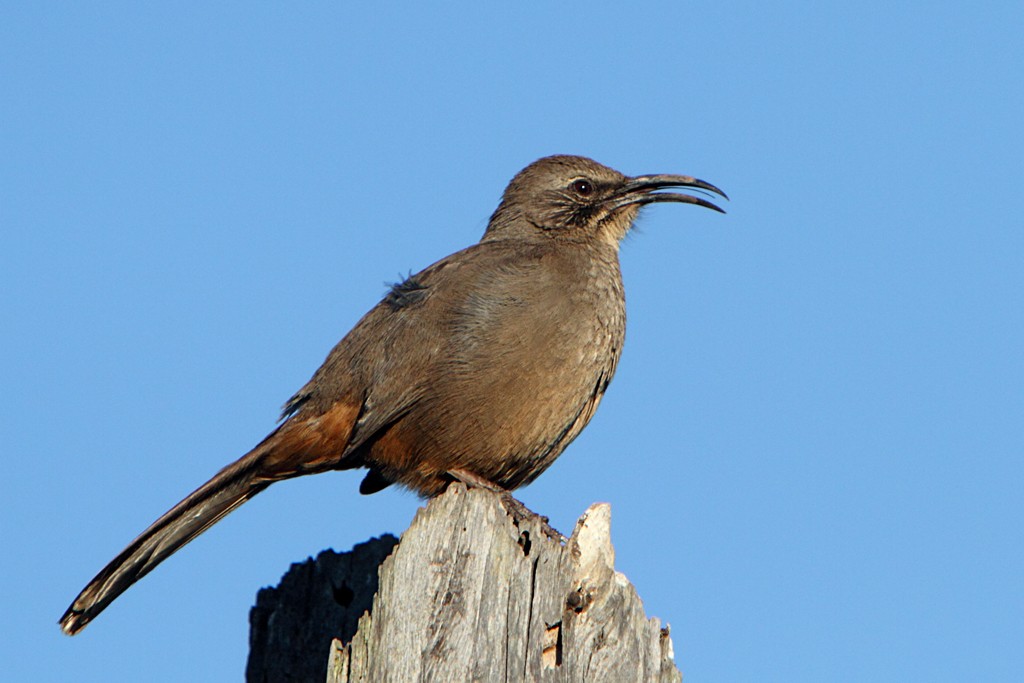California Thrasher
A species of American Thrashers Scientific name : Toxostoma redivivum Genus : American Thrashers
California Thrasher, A species of American Thrashers
Botanical name: Toxostoma redivivum
Genus: American Thrashers
Content
Description People often ask General Info
Description
The California thrasher (Toxostoma redivivum) is a large thrasher found primarily in chaparral habitat in California and Baja California. Similar to the crissal and Le Conte's thrashers in habit, the California thrasher is the only species of Toxostoma throughout most of its limited range. Like most thrashers, it rarely flies in the open, preferring to keep hidden in dense brush. Therefore, while it is common throughout much of its range, it is rarely seen. At about 12 in (30 cm) and nearly 85 g (3.0 oz), the California thrasher is the largest species of mimid. It has a distinctive long, decurved beak, and is generally brown, with buffy underparts and undertail (unlike the crissal). It has a dark cheek pattern and eye-line, and unlike most thrashers, has dark eyes. The California thrasher eats insects and small invertebrates, which it uncovers by tossing its beak in ground litter. 
Size
28-33 cm (11-13 in)
Colors
Brown
Black
Yellow
Gray
White
Life Expectancy
6 years
Nest Placement
Shrub
Clutch Size
1 - 6 eggs
Feeding Habits
California Thrasher's diet changes seasonally, with a focus on arthropods during the rainy/breeding season and berries in late summer as insects decline. They forage by sweeping their bill in leaf litter and probing the ground. Their diet includes beetles, spiders, Jerusalem crickets, ants, as well as fruits like poison oak and elderberry.
Habitat
California Thrasher commonly reside within chaparral, foothills, and valley thickets, often extending to suburban parks and gardens. They seek elevations with diverse vegetation including shrubs like ceanothus and manzanita, increasingly nesting in sagebrush habitats towards the south. California Thrasher prefer mixed scrub and woodlands, thriving in the transitional zones with oaks and pines, provided there is ample leaf litter. They avoid open woodlands sans underbrush and areas approaching deserts, where their habitat overlaps with similar species.
Nest Behavior
The pair partakes in nest building, followed by laying eggs. Parental duties from both include incubation and chick rearing. The specifics of timing and egg-laying patterns are comparable with similar thrasher species.
Nest Characteristics
California Thrasher builds nests around 7 feet high in dense shrubbery. The nests are constructed by both sexes and are bulky platforms of twigs lined with roots, stems, bark, forbs, and weeds. They measure approximately 10 inches in width, 5 inches in height, with an inner cup about 4 inches wide and 2 inches deep.
Dite type
Insectivorous
People often ask
General Info
Feeding Habits
Bird food type
Bird Feeder Type

Ground
Sounds
Call
Recording location: United States
Song
Recording location: United States
Song
Recording location: United States
Behavior
California Thrasher form enduring pair bonds and demonstrate understated courtship rituals within their dense brush habitats, which include tail and head displays alongside wing fluttering by the perched females. In the breeding season's dawn, females may occasionally join males in their melodies. Year-round, these pairs forage in tandem, defending their territory with resolve. Aggression is reserved for interlopers, signaled by distinct low chup calls. A prolific species, california Thrasher typically raise two broods annually, with a parental tactic of nudging the first brood out to make room for the succeeding. The male may support the first brood even as the female invests in the next generation, building a second nest. Their territories fluctuate between 6 to over 25 acres depending on the habitat's bounty.
Species Status
Not globally threatened.
Scientific Classification
Phylum
Chordates Class
Birds Order
Perching birds Family
Mimids Genus
American Thrashers Species
California Thrasher 